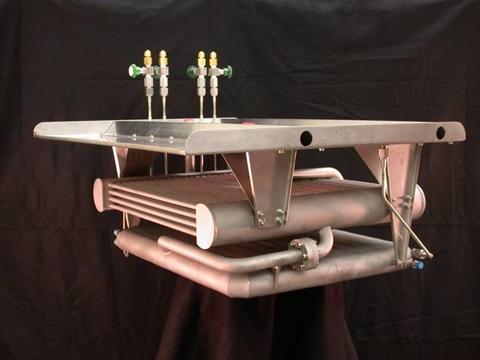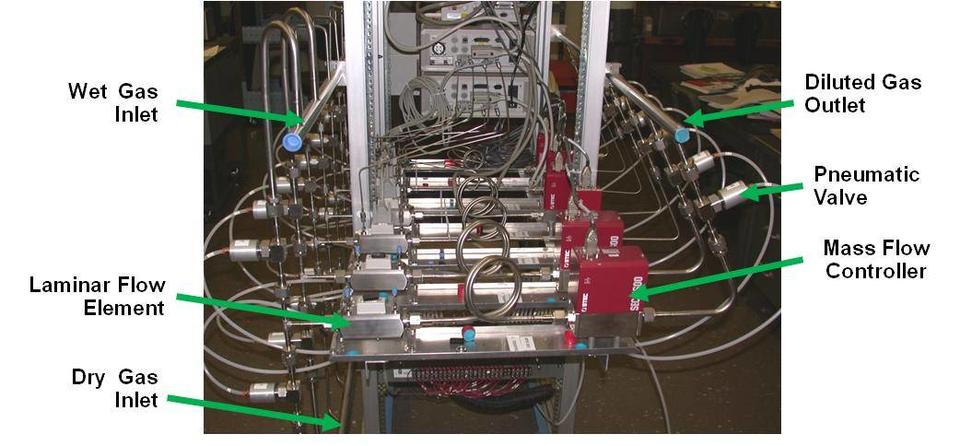Summary
Humidity calibrations at NIST are performed using its state-of-the art primary standard humidity generator. Calibrations are performed on instruments that measure water amount fraction (mole fraction), dew point, and relative humidity. Special tests on humidity-measuring instruments may also be performed using the generator.
To order a calibration or test, go to Special Tests of Humidity (36070S).
Description

Heat exchanger and saturator of the Hybrid Humidity Generator
Humidity calibration services at NIST are performed with its primary standard humidity generator, the Hybrid Humidity Generator (HHG). The HHG produces humidified air of known moisture content over the dew/frost-point range from -90 °C frost point to +85 °C dew point, which corresponds to a water vapor amount fraction range 1.0 × 10-7 to 0.57. The output of the HHG may be used for the calibration of dew/frost-point and amount-fraction (mole-fraction) hygrometers at pressures near 100 kPa. The output of the HHG can be directed to a temperature-controlled chamber for calibration of thermohygrometers (which measure both temperature and relative humidity) in air. The chamber can be controlled at temperatures over the range –34 °C and 190 °C. This allows calibration of thermohygrometers over the relative humidity range 2 % to 98 % for temperatures between −34 °C and 85 °C, as well as well as over more limited relative-humidity ranges between 85 °C and 190 °C.
Calibration Uncertainties
For dew/frost point temperatures, the HHG uncertainty budget yields a total expanded uncertainty (k = 2) of less than 0.025 °C for dew/frost point temperatures above –60 °C. For mole fraction, the budget yields a total expanded relative uncertainty of less than 0.2 % for mole fractions above 2 × 10−5. For relative humidity in the test chamber, the budget yields a total expanded relative uncertainty of less than 0.3%.
Technical Approach
The NIST HHG incorporates the two-pressure and divided-flow principles into a single, modular humidity generator design. The generator operates purely as a two-pressure generator for dew/frost-point temperatures greater than or equal to −10 °C. When operating as a two-pressure generator, various humidity test points are produced by flowing a stream of CO2-free air over isothermal water under conditions of constant temperature and pressure within the saturator of the humidity generator. By ensuring that the inlet gas stream has reached thermodynamic equilibrium with the water, the amount fraction of water vapor in the gas phase can be calculated from known thermodynamic properties and is proportional to the vapor pressure of the water and the enhancement factor. This latter quantity is close to unity and accounts for departures from ideal solution behavior as well as non-ideal gas effects. The saturator of the HHG has an exceptionally high flow capacity of 150 standard liters per minute, allowing calibration of a wide range of specialized hygrometers.
Once saturated with water vapor, the gas mixture is expanded to a lower pressure. The water vapor partial pressure associated with the gas expansion is proportional to the ratio of total gas pressure at saturation to total gas pressure after expansion. Since the new water vapor pressure corresponds to a new dew-point temperature, a variety of dew-point temperatures may be generated for a given saturator temperature. In practice, the lower pressure value is kept constant at a value near 100 kPa, and the pressure within the saturator is varied. Feedback control of a butterfly valve is used to actively stabilize the operating pressure.
In order to generate frost-point temperatures below –10 °C, the HHG is reconfigured as a divided-flow generator, in which CO2-free air, saturated by the HHG saturator, is mixed with purified ultra-dry air. Commercial laminar-flow elements provide accurate measurements of the molar flow rates of the metered streams of moist air produced by the HHG's two-pressure generator, and the purified diluent, respectively. Use of a high-performance air purifier for the diluent gas and careful attention to plumbing design and construction reduces the background water level in the diluent gas to less than 1 part in 109.

Equivalence with other National Metrology Institutes
NIST has participated in two multilateral comparisons involving dew/frost points. These comparisons, organized by the International Committee of Weights and Measures (CIPM) Consultative Committee on Thermometry (CCT), are CCT-K6 (dew/frost-point range -50 °C to 20 °C, completed) and CCT-K8 (30 °C to 90 °C, report in progress). Participants in these comparisons have included Austria, China, Finland, Italy, Japan, Netherlands, Russia, Singapore, South Korea, Spain, and the United Kingdom. NIST has also piloted a bilateral comparison with Japan. As part of the Inter-American Metrology System (SIM), NIST has piloted bilateral comparisons with Brazil, Canada, Costa Rica, and Mexico, and is currently planning a bilateral comparison with Colombia. All the completed comparisons have demonstrated the equivalence of NIST standards with those of the other participating countries to within the uncertainties of the humidity standards and the comparison measurements.

